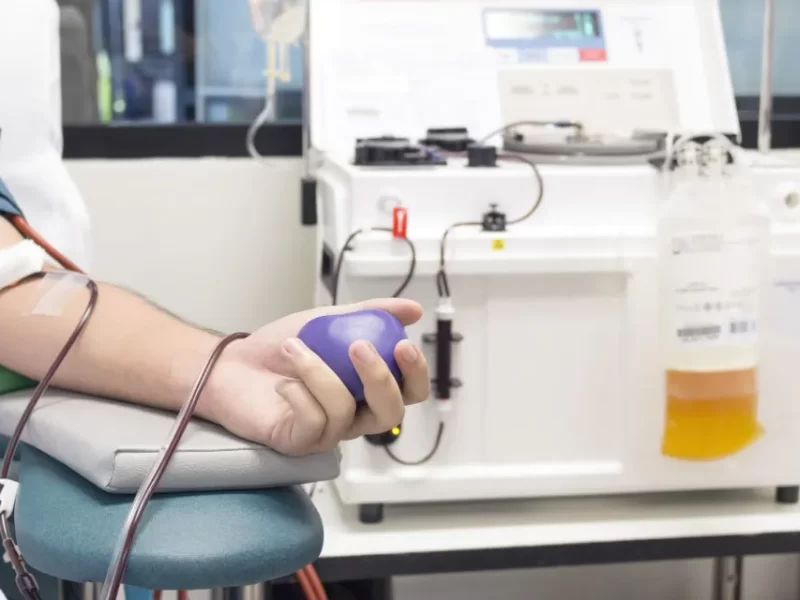The total amount of oxygen circulating in the blood is indicated by the blood oxygen level, also referred to as oxygen saturation. It is simple to take breathing for granted because we do it automatically.
But as people get older, they’re more likely to get respiratory issues and have trouble breathing. If you want to maintain or raise your blood oxygen level, you can do so naturally or you can discuss your options with your doctor. Read this article and you can learn how to increase your blood oxygen level.
What Is Blood Oxygen Level?
The quantity of oxygen in your blood is known as your blood oxygen level. Pulse oximetry, which we’ll talk more about later, is the most popular technique for measuring it. Too little blood oxygen in your body can signal or be a symptom of a number of medical conditions.
Your body needs a steady supply of oxygen to function properly. Red blood cells carry oxygen throughout your body after it has entered your lungs and left your lungs for the bloodstream.
The red blood cells’ ability to distribute oxygen throughout your body is indicated by your blood’s oxygen level, so it’s crucial for your overall health to keep the right balance of oxygen saturation.
What Are Typical Levels of Blood Oxygen?
The functionality of your heart, lungs and circulatory system can all be determined by your blood oxygen level. Between 95% and 100% of a healthy person’s blood is typically oxygenated. Because of this, almost all of your blood’s red blood cells are supplying oxygen to your tissues and cells.
Lower readings are typical for those who live at higher altitudes or have certain types of chronic illnesses, such as asthma, emphysema, or chronic obstructive pulmonary disease (COPD).
A reading of 90% to 92% is regarded as having a low oxygen level, also known as hypoxemia. A reading this low indicates that you may require additional oxygen or that there may be problems that affect how your lungs work. If your score is less than 90%, you should see a doctor.
How Is The Blood’s Oxygen Level Measured?
A pulse oximeter is used to measure blood oxygen, also known as oxygen saturation. It’s a tiny gadget that attaches to your finger (or other body parts) and measures the proportion of red blood cells carrying oxygen to those that are empty.
Monitoring or checking blood oxygen levels is painless and non-invasive. Using a pulse oximeter to check your blood oxygen level is safe and without known risks.
A pulse oximeter emits light that travels through your fingernail, skin, tissue, and blood to a sensor on the other side. The instrument gauges how much light made it through without being absorbed by blood or tissue. The amount of oxygen in your blood is then calculated using that measurement.
How To Increase Your Blood Oxygen Level
You can increase the amount of oxygen in your blood by doing a variety of things. Immediately after that:
- Stand or sit up straight. Rather than lying down, which may put pressure on your lungs and make it harder to breathe.
- Cough. If you have a cold or the flu, difficulty breathing can decrease oxygen saturation in your blood. By clearing your airway and releasing secretions, coughing may help.
- Go outside. Fresh air is healthy for your lungs and typically contains more oxygen. Your breathing might be hampered if it’s extremely hot or cold outside.
- Drink lots of water. The ability of your lungs to distribute oxygen into your bloodstream is improved by proper hydration.
- Take slow, deep breaths. Your lungs should receive more air as a result.
Likewise, over a longer period of time:

- Practice breathing exercises. Increased lung capacity and increased blood oxygenation are both benefits of practicing deliberate breathing techniques.
- Be active. You can breathe more quickly and thus inhale more oxygen when you are physically active. Exercising your lungs benefits them in the same way that working out your body improves your fitness.
- If you smoke, quit. It comes as no surprise that your blood oxygen level will also benefit quickly from this in a very short period of time.
- Get house plants. Because they absorb carbon dioxide and release oxygen, plants improve indoor air quality and make it more similar to outdoor air.
- Consume iron-rich foods. Getting more iron in your diet may help your red blood cells, which are in need of iron, function better (and transport more oxygen through your blood).
Symptoms Of Low Blood Oxygen Levels
Low blood oxygen levels may cause the following symptoms:
- Shortness of breath
- Heavy breathing
- Chest pains
- Elevated heart rate
- Increased blood pressure
- Dizziness
- Loss of coordination
- Confusion
- Headaches
- Impaired vision
- Cyanosis
Low levels of oxygen in your blood can result from environmental changes, such as moving to a higher altitude where there is less oxygen in the air, in addition to certain medical conditions.
What If My Blood Oxygen Level Is Too Low?
Your doctor might have you start taking supplemental oxygen if the level of oxygen in your blood is low. This treatment can help raise your blood oxygen level by giving you more oxygen than what is found in typical room air.
It’s typically administered via a face mask or a nasal cannula, a tiny plastic hose with prongs that fit into your nostrils.
For patients with chronic conditions like COPD, pulmonary fibrosis, cystic fibrosis, or sleep apnea, doctors may recommend long-term oxygen therapy. Short-term oxygen therapy may be administered to patients in situations like the aftermath of an accident or an acute illness.
Supplemental oxygen can help you feel better, recover more quickly, and stay active while managing these conditions.



